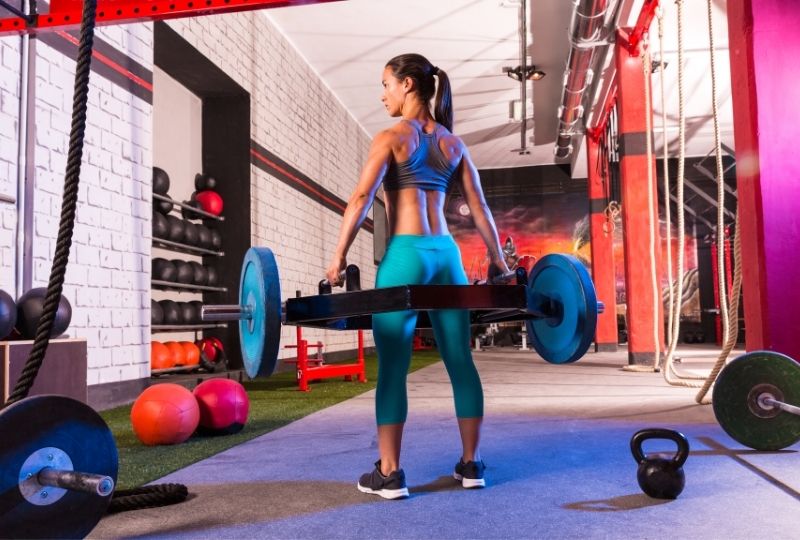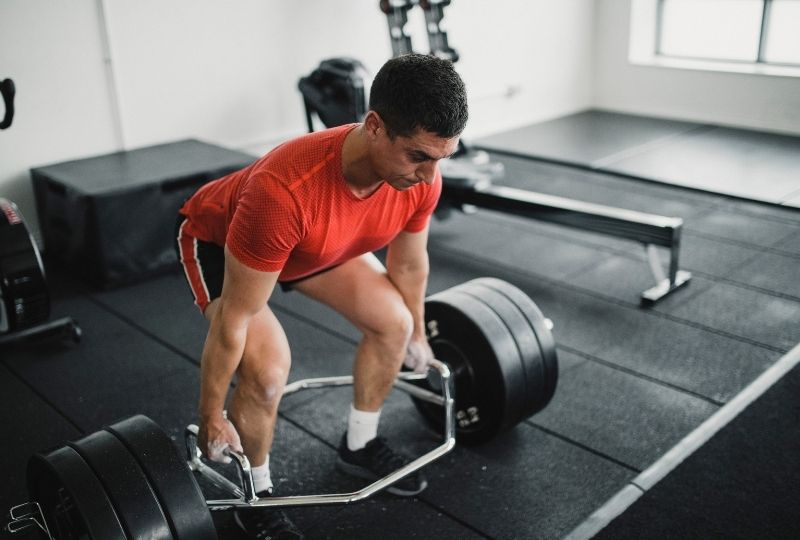What's inside
Have you ever wanted to try using a trap bar at the gym but don’t know whether it’s a good training choice?
If this is you, don’t worry, you’re not alone.
Many of us (myself included) gravitate toward our favorite training equipment for comfort and familiarity.
Be it the size, the grips pattern, or the overall weight, we like the predictability and the sureness that we will have a great session.
But what if I told you there were many benefits to using the trap bar? In fact, you may get better results with the trap bar than with a straight bar.
Today, let’s discuss how much does a trap bar weigh and compare 21 hex bar brands. I’ll also share with you some reasons why you need to consider using one in your training program.
Table of Contents
- What is the difference between a trap bar and hex bar?
- Why use a trap bar (hex bar)?
- What is a trap bar made of?
- Top Model Trap Bar (Hex Bar) Weights
- Benefits of Using a Trap Bar or Hex Bar
- Types of Trap Bar/Hex Bars
- What is the ACFT hex bar weight?
- What is the Olympic trap bar weight?
- Is the hex bar easier?
- Can you squat with the hex bar?
- Why is it called a trap bar?
- Is deadlift with a trap bar better?
- Can trap bar deadlifts replace squats?
- Final Thoughts
What is the difference between a trap bar and hex bar?
The trap bar and hex bar are the same pieces of equipment. Originally created by Al Gerard in the 1980s, the bar takes its name after its hexagonal shape.
It is also named trap bar, as it engages the fibers of the trapezius. The bar design also allows for shrugging and upright rowing.

Why use a trap bar (hex bar)?
The trap bar is designed to let us perform deadlifts and squats with less consideration of the bar path typical of conventional straight bar deadlifts.
This is potentially due to removing the need to consider a straight bar path.
A trap bar provides a greater level of comfort and freedom of movement at the knees, hips, and shoulders. It allows the lifter to focus more on moving the weight and less on the technical aspects of the lift.
This makes it great for individuals who are suffering from injuries in the above-mentioned areas, as well as beginners who are new to deadlifting.
What is a trap bar made of?
Trap bars are typically made from stainless steel or chrome. Some bars use steel entirely, while others use steel with chrome plating for an aesthetically pleasing finish.
Top Model Trap Bar (Hex Bar) Weights
Related: Smith Machine Bar Weights
Below is my list of 21 hex bars, which you will notice have a variety of different weights. This can be due to their design, shape, and build quality.
When creating this list of trap bars, it was noted that there was no relationship between brand and increased weight.
Rather, brands such as Eleiko, Kabuki, and Rogue assume a higher price point due to their reputation and build quality.
If you need to find the weight of the trap bar at your gym, but it isn’t on this list, there are a few things you can do.
First, you can look at either end of the bar where the weights go. On the flat surface, bars typically list weight and brand.
If the bar weight isn’t displayed you can simply find the brand and search the company website for bar specifications.
How Much Does A Trap Bar Weigh? (By Brand)
| Make | Weight (Kg) | Weight (lbs) |
| Armortech Hex Trap Bar | 24kg | 53lbs |
| Bells of Steel | 21kg | 47lbs |
| Kabuki Strength Trap bar | 30kg | 66lbs |
| Rep Fitness | 25kg | 55lbs |
| GYMAX Olympic | 24kg | 53lbs |
| Vulcan Prime Hex Trap Bar | 27kg | 60lbs |
| Alphafit | 23kg | 50lbs |
| Titan | 27kg | 60lbs |
| Rogue trap bar weight | 27kg | 60lbs |
| Force USA | 20kg | 44lbs |
| Force USA Walkthrough | 30kg | 66lbs |
| Iron Edge | 23kg | 50lbs |
| Gym Direct | 30kg | 44lbs |
| Hammer Strength | 27kg | 60lbs |
| Eleiko | 25kg | 55lbs |
| CAP | 21kg | 46lbs |
| Sumo Strength | 30kg | 66lbs |
| Commercial Fitness | 24kg | 53lbs |
| Little Bloke Fitness | 22kg | 49lbs |
| Catch Fitness | 22kg | 49lbs |
| Elite Fitness | 30kg | 66lbs |
Benefits of Using a Trap Bar or Hex Bar
Trap bars are a great piece of equipment with a number of benefits that can improve our lifting.
Here are some reasons you need to consider picking up a trap bar next time you train.
Improved Performance
Research indicates increased mechanical stimulus while using a trap bar.
There may be greater peak force, peak velocity, and peak power while using a trap bar over a straight bar.
The bar itself allows users to perform lifts with more freedom at the same level of resistance.
Comfortable Grip
Related: What Are the Benefits of Hand Grip Exercises?
The trap bar’s grip position is incredibly comfortable as the neutral grip position allows us to hold the bar with our arms relaxed at our sides.
This hand position means we can remain upright without the pulling forward that is found with straight bar deadlifts.
The neutral grip also allows us to retract our shoulder blades and engage the muscles of the upper and mid-back. This is crucial to lifting weights from the floor.
No Bar Path Consideration
The trap bar’s hexagonal shape allows us to lift without the consideration of the bar path.
With straight bar deadlifts, we must always consider lifting the bar directly up and down off the floor for energy efficiency.
However, considering our knee position when lifting can be difficult for beginners.
The trap bar removes this factor and allows us to concentrate on the lift as it accommodates our personal flexibility and joint range of motion.
Easier to Learn Than Barbell Deadlift
Related: What Does PR Mean In The Gym?
The design of the hex bar lets beginners perform the movement without the restriction of a straight bar at the front of their knees and shins.
The positioning of the handles also helps them to remain upright with a more natural posture throughout the lift.
This allows them to lift weight in a way that mimics daily tasks such as carrying shopping bags.
No Pull Forward
Hex bars allow us to lift without the pulling forward that is found in straight bar deadlifting.
The ability to stand in the middle of the hex bar means that we are directly in line with the bar and the weights on either side.
This means the resistance is straight up and down rather than forward, reducing flexion at the hips and pressure on the spine when performing our lifts.

Types of Trap Bar/Hex Bars
Over time, the trap bar has evolved. Companies are creating a more versatile and ergonomic lifting tool that allows for great comfort or functionality.
Here are some of the current types on the market.
Traditional/Gerard
The traditional or Gerard trap bar is the original and most common. The bar was designed with a closed hexagon shape that allows lifters to stand in the middle.
This eliminates the need to consider bar path and keeps users in the upright position while decreasing pressure on the lower back.
Open
With an open trap bar, users can perform additional movements such as lunges and carries without the need to consider hitting the edge of the bar.
Open bars are one-sided hexagons designed with counterweights on the opposite ends for balance.
This offers the added bonus of being able to rest them upright for storage and horizontal for lifting.
Adjustable
The adjustable trap bar is designed with the ability to change the handle position on either side of the bar.
This is simply done with easy-change grips that can be adjusted inward or outward depending on the size and preferences of the individual.
This increases comfort through the shoulder and lower back, allowing them to focus on our lifts.
What is the ACFT Hex Bar Weight?
The Army Combat Fitness Test (ACFT) hex bar weight requirement is listed at 60 pounds.
The military uses the hex bar deadlift to assess and train the lower body, grip, and core strength, with the aim of reducing injury and improving endurance and flexibility.
What is the Olympic trap bar weight?
Trap and hex bars’ weight can range between 44lbs – 66lbs depending on size, make, and model. Brands create their bars to target different styles and types of training.
This can alter the design as different companies apply slight variations to handle position, structure, and weight distribution. Ultimately changing the overall weight and feel of the bar.
Is the hex bar easier?
The hex bar is easier to use as its open design accommodates our joint range of motion and flexibility – things that aren’t always possible with a straight bar.
This helps us to assume a more gentle position when performing squats and deadlifts.
Can you squat with a hex bar?
Squats can be performed with a trap bar as the handles assume the same position at the side of the hips as a dumbbell squat.
The design of the bar allows us to assume a more upright position that replicates that of a front squat and back squat.
Why is it called a trap bar?
The trap bar was named as it engages the muscles of the trapezius when performing exercises such as carries or shrugs.
Is deadlifting with a trap bar better?
It is noted that deadlift with a trap bar can improve performance while decreasing spinal load.
The trap bar allows us to lift vertically with less hip flexion, reducing forward pressure.
Can trap bar deadlifts replace squats?
Trap bar deadlifts can be used as a substitute for squats as the movement utilizes the same muscles of the back, hips, and knees.
The benefit to using the trap bar is that it does not require the loading of the spine that is found in a barbell back squat.
Final Thoughts
The trap bar (hex bar) is a fantastic piece of equipment that allows us to perform movements such as squats and deadlifts while accommodating our biomechanics and injuries.
And while not all bars are the same, all designs from their inception in the 80s have had one thing in common – to support the lifter.
So, if you feel restricted by straight bar training or injuries, why not try the trap bar?
With noted benefits to performance and freedom of movement, there are so many reasons why you should include it in your next workout.
Do you use the trap bar regularly? Let me know in the comments, and be sure to share this article with someone who needs it.

